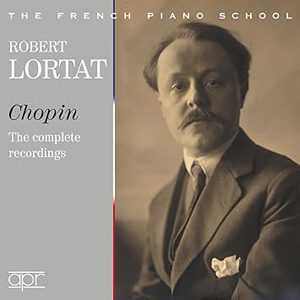Robert Lortat (1885-1937) was one of several prominent pianists who studied with Louis Diémer, including Robert Casadesus, Edouard Risler, Yves Nat, and Alfred Cortot. He earned acclaim for giving comprehensive Chopin cycles, while possibly being the first to play Fauré’s complete piano works in public. Although health problems somewhat curtailed his career after World War I, Lortat still managed to set down a small discography between 1928 and 1931, encompassing Chopin’s Preludes Op. 28, the standard Fourteen Waltzes, the Funeral March sonata, and all of the Etudes.
In the main, Lortat’s Chopin is relatively cut and dried, characterized by the kind of finger-oriented projection we hear from Marguerite Long and Jeanne-Marie Darré. The G major Prelude’s precipitous 16th-note left-hand runs are perfectly in place, while controlled passion governs the F-sharp minor’s impeccably delineated textures. Lortat’s animated, easily floating D-flat “Raindrop” Prelude is just the antidote to today’s interminable “slow equals profound” performances. The taxing B-flat minor Prelude is both virtuosic and thoughtfully shaped from a harmonic and dynamic standpoint. On the other hand, Lortat’s typewriter-like left-hand ostinatos in the D minor reduce the music’s tumultuous undercurrents to an anti-climax.
The remaining selections are uneven. In the Waltzes, the subjective inflections throughout the E-flat Op. 18, the three A-flat selections, and the E minor convey a strong and purposeful profile. Conversely, the lurching rhythms and sudden dynamic surges in the F major Op. 34 No. 3 and C-sharp minor Op. 64 No. 2 splatter all over the map. The Etudes range from rhythmically stiff and occasionally labored (Op. 10 Nos. 1, 4, and 7; Op. 25 Nos. 3 and 6, the A-flat Nouvelle Etude) to commanding and imaginative (Op. 10 Nos. 11 and 12, Op. 25 Nos. 1, 7, 10, and 11, the F minor and D-flat Nouvelle Etudes).
Lortat tears through the sonata’s first movement at a breakneck pace, with lots of rhetorical leeway in the process. He brings comparable fervency and power to the Scherzo’s outer sections, although he rushes the rapid ascending chromatic chords, and also shortchanges crucial beats in a similarly intense Funeral March. The Presto finale sounds matter-of-fact next to the epic Rachmaninov and Friedman 78 rpm versions, but Lortat’s unison lines are crisp, clean, and evenly balanced between the hands. While “old school” pianists take a pause between the final crashing B-flat octave followed by a B-flat minor chord, Lortat plays the passage as written.
Mark Obert-Thorn’s new transfers drastically improve on those in the earlier Dante and Doremi complete Lortat editions. They boast greater presence and definition, and are properly pitched, while uncovering more room tone. APR’s release further benefits from Frédéric Gaussin’s extensive and thoroughly researched annotations.
































